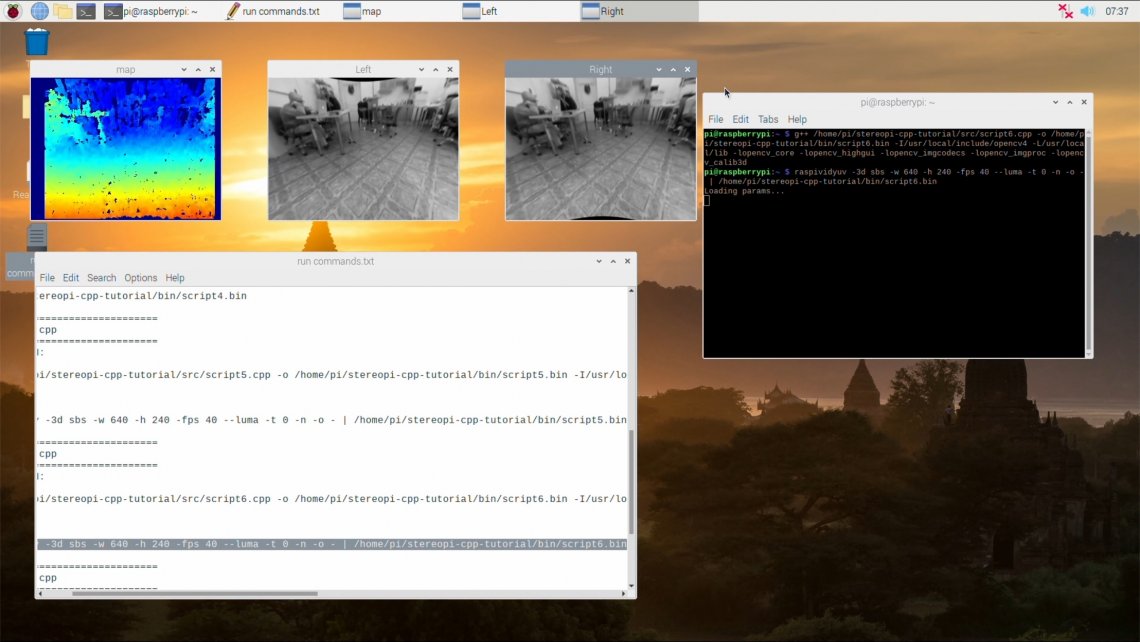OpenCV-Python Interface Performance: cv vs cv2
This article compares the performance of OpenCV-Python interfaces, cv and cv2, to help you choose the best option for your computer vision projects.
This article compares the performance of OpenCV-Python interfaces, cv and cv2, to help you choose the best option for your computer vision projects.
OpenCV, a versatile library for computer vision tasks, offers interfaces for both Python and C++, each with its own strengths. Python, known for its ease of use and rapid development capabilities, can be used effectively with OpenCV, especially with the cv2 module that leverages the power of NumPy for numerical operations. On the other hand, C++, a compiled language, often excels in performance-critical applications.
OpenCV, a powerful computer vision library, can be used with both Python and C++. While Python offers faster development, C++ often provides better performance.
Python's OpenCV interface has evolved. The older cv module lacked NumPy integration, making it slower. The newer cv2 module leverages NumPy, significantly boosting speed.
# Using cv2 with NumPy for faster processing
import cv2
image = cv2.imread("image.jpg")For performance-critical applications, C++ might be preferable. However, Python with cv2, especially when utilizing NumPy effectively, can be surprisingly fast.
// C++ code for OpenCV
#include <opencv2/opencv.hpp>
int main() {
cv::Mat image = cv::imread("image.jpg");
// ... further processing
}Ultimately, the choice depends on the project's specific needs. If development speed is paramount, Python is a strong contender. If performance is critical, C++ might be the better option.
The code examples demonstrate edge detection in an image using OpenCV, comparing Python and C++ implementations. Both versions load an image, convert it to grayscale, apply Gaussian blur, and detect edges using the Canny algorithm. They also measure and print the execution time, highlighting the potential performance differences between the two languages. While Python offers conciseness, C++ might provide an edge in speed for computationally demanding image processing tasks.
import cv2
import time
# Load image
image = cv2.imread("image.jpg")
# Start timer
start_time = time.time()
# Convert to grayscale
gray = cv2.cvtColor(image, cv2.COLOR_BGR2GRAY)
# Apply Gaussian blur
blurred = cv2.GaussianBlur(gray, (5, 5), 0)
# Detect edges using Canny
edges = cv2.Canny(blurred, 50, 150)
# End timer
end_time = time.time()
# Calculate and print execution time
print("Execution time (Python):", end_time - start_time)
# Display results
cv2.imshow("Original", image)
cv2.imshow("Edges", edges)
cv2.waitKey(0)#include <opencv2/opencv.hpp>
#include <chrono>
int main() {
// Load image
cv::Mat image = cv::imread("image.jpg");
// Start timer
auto start_time = std::chrono::high_resolution_clock::now();
// Convert to grayscale
cv::Mat gray;
cv::cvtColor(image, gray, cv::COLOR_BGR2GRAY);
// Apply Gaussian blur
cv::Mat blurred;
cv::GaussianBlur(gray, blurred, cv::Size(5, 5), 0);
// Detect edges using Canny
cv::Mat edges;
cv::Canny(blurred, edges, 50, 150);
// End timer
auto end_time = std::chrono::high_resolution_clock::now();
// Calculate and print execution time
auto duration = std::chrono::duration_cast<std::chrono::milliseconds>(end_time - start_time);
std::cout << "Execution time (C++): " << duration.count() << "ms" << std::endl;
// Display results
cv::imshow("Original", image);
cv::imshow("Edges", edges);
cv::waitKey(0);
return 0;
}Explanation:
Both code examples perform the same image processing tasks:
cv2.imread() in Python and cv::imread() in C++.cv2.cvtColor() in Python and cv::cvtColor() in C++.cv2.GaussianBlur() in Python and cv::GaussianBlur() in C++.cv2.Canny() in Python and cv::Canny() in C++.The key difference lies in the language syntax and how time is measured.
time module for timing, while C++ utilizes std::chrono.This example demonstrates a simple image processing pipeline. For more complex applications, the performance difference between Python and C++ might be more significant. You can experiment with both versions and compare their execution times to determine the best option for your specific needs.
Ease of Use vs. Performance: The choice between Python and C++ for OpenCV often boils down to this trade-off. Python, especially with the cv2 module, offers a more beginner-friendly syntax and faster development times. C++, while more complex, can yield significant performance gains, crucial for real-time applications or processing large datasets.
NumPy's Role: NumPy is a powerful Python library for numerical computations. The cv2 module seamlessly integrates with NumPy, allowing OpenCV to leverage its optimized functions for array operations, leading to substantial speed improvements compared to the older cv module.
Beyond the Basics: While the provided examples focus on basic image processing, OpenCV offers a vast range of functionalities, including object detection, tracking, machine learning, and more. The performance difference between Python and C++ might vary depending on the specific algorithms and techniques used.
Optimization Techniques: Both Python and C++ code can be further optimized. In Python, consider using vectorized operations with NumPy, profiling your code to identify bottlenecks, and exploring libraries like Cython for bridging Python and C code. In C++, focus on efficient memory management, algorithm optimization, and utilizing compiler optimizations.
Project Scope and Requirements: The best choice ultimately depends on the specific project. For small-scale projects, prototyping, or applications where development speed is paramount, Python with cv2 is a strong contender. For performance-intensive tasks, real-time systems, or resource-constrained environments, C++ might be the more suitable option.
Community and Resources: OpenCV has a large and active community, with abundant resources available for both Python and C++. This makes it easier to find solutions, tutorials, and support for either language.
| Feature | Python | C++ |
|---|---|---|
| Development Speed | Faster | Slower |
| Performance | Good with cv2 and NumPy |
Often better |
| OpenCV Interface |
cv (older, slower) and cv2 (newer, leverages NumPy) |
Native |
| Best Use Cases | Projects where development speed is prioritized | Performance-critical applications |
Summary:
Both Python and C++ are viable options for using OpenCV. Python, particularly with the cv2 module and NumPy, offers faster development and surprisingly good performance. C++ might be more suitable for applications where performance is paramount. The best choice depends on the specific project requirements.
In conclusion, both Python and C++ offer distinct advantages when working with OpenCV. Python, particularly with the cv2 module and NumPy, excels in ease of use and rapid development, making it suitable for projects where development time is crucial. Its intuitive syntax and abundance of libraries empower developers to quickly prototype and implement computer vision tasks. On the other hand, C++, being a compiled language, shines in performance-critical applications. Its ability to directly interact with hardware and memory management makes it ideal for resource-intensive or real-time systems where speed is paramount. Ultimately, the choice between Python and C++ for OpenCV hinges on the specific project requirements, balancing the need for development speed with the demand for computational performance.
 Python vs C++ (personal experiences with using both) - programming | I’m planning to use Python for my upcoming project as a way to understand OpenCV. C++ seems like a uphill battle with a cherry on top. Though, I’d like to learn OpenCV with C++ in the future. Does anyone want to share their personal experiences working with both languages and any issues they faced? From what I know online, C++ for speed and Python for coding quickness. However, there must some small things that each language offers to make OpenCV experience better and vice versa.
Python vs C++ (personal experiences with using both) - programming | I’m planning to use Python for my upcoming project as a way to understand OpenCV. C++ seems like a uphill battle with a cherry on top. Though, I’d like to learn OpenCV with C++ in the future. Does anyone want to share their personal experiences working with both languages and any issues they faced? From what I know online, C++ for speed and Python for coding quickness. However, there must some small things that each language offers to make OpenCV experience better and vice versa. OpenCV in the Browser? Lets give it a try - Software - Kinograph ... | Hi guys, I’ve been working my software and decided to take on the challenge of testing OpenCV running in the browser. The goal was simple : create a standalone device where Python code controls the motor, camera, and handles exposure bracketing, saving the data on a fast SSD. The GUI is a web interface (specifically Vue) that interacts with a Flask API. So you only need a web browser on any device within the same network, be it a tablet or an old smartphone to control the process. Why the has...
OpenCV in the Browser? Lets give it a try - Software - Kinograph ... | Hi guys, I’ve been working my software and decided to take on the challenge of testing OpenCV running in the browser. The goal was simple : create a standalone device where Python code controls the motor, camera, and handles exposure bracketing, saving the data on a fast SSD. The GUI is a web interface (specifically Vue) that interacts with a Flask API. So you only need a web browser on any device within the same network, be it a tablet or an old smartphone to control the process. Why the has... OpenCV - Open Computer Vision Library | OpenCV provides a real-time optimized Computer Vision library, tools, and hardware. It also supports model execution for Machine Learning (ML) and Artificial Intelligence (AI).
OpenCV - Open Computer Vision Library | OpenCV provides a real-time optimized Computer Vision library, tools, and hardware. It also supports model execution for Machine Learning (ML) and Artificial Intelligence (AI). OpenCV: comparing the speed of C++ and Python code on the ... | OpenCV: comparing the speed of C++ and Python code on the Raspberry Pi for stereo vision. StereoPi Python C++.
OpenCV: comparing the speed of C++ and Python code on the ... | OpenCV: comparing the speed of C++ and Python code on the Raspberry Pi for stereo vision. StereoPi Python C++. Getting Started with OpenCV CUDA Module | In this post, we will learn how to speed up OpenCV algorithms using CUDA on the example of Farneback Optical Flow
Getting Started with OpenCV CUDA Module | In this post, we will learn how to speed up OpenCV algorithms using CUDA on the example of Farneback Optical Flow